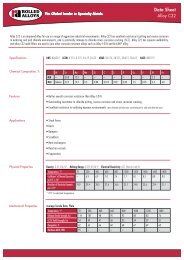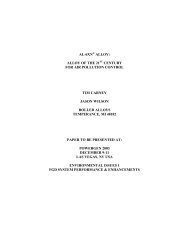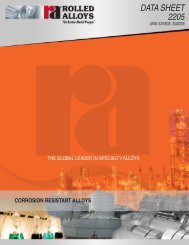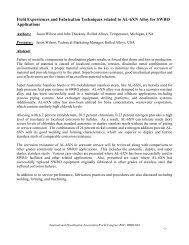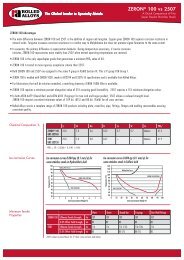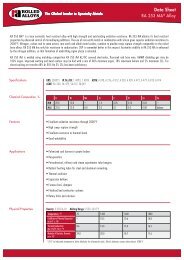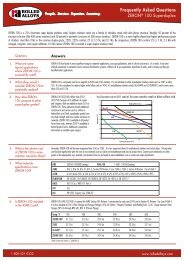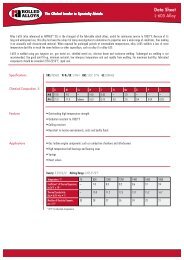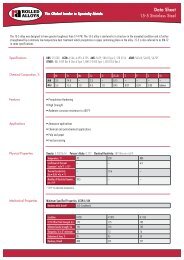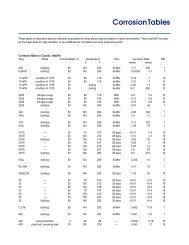Molten Metals [Heat Resistant Alloys (Environments)] - Rolled Alloys
Molten Metals [Heat Resistant Alloys (Environments)] - Rolled Alloys
Molten Metals [Heat Resistant Alloys (Environments)] - Rolled Alloys
You also want an ePaper? Increase the reach of your titles
YUMPU automatically turns print PDFs into web optimized ePapers that Google loves.
<strong>Molten</strong> <strong>Metals</strong>, continued<br />
Antimony—we have no definite experience. There are indications that lead baths which<br />
have been contaminated by antimony, from using scrap lead, are corrosive to Ni-Cr-Fe<br />
alloys.<br />
Bismuth—To satisfy OSHA, one American file manufacturer switched from molten lead to<br />
bismuth in its 1450°F (788°C) austenitizing baths. The lead, now bismuth, pots are<br />
fabricated of RA330 plate welded with RA330-04 (35%Ni 19%Cr %Si 5%Mn 0.25%C) weld<br />
filler. These pots have two loops of 2” Sch 40 RA330 pipe welded to the bottom. An<br />
induction coil fits through the loops and heats the bismuth. When too much heat is<br />
applied, the loops are attacked. When maintained at 1450°F (788°C) no problems have<br />
been reported to us.<br />
Cadmium—We have no experience with the effects of Cd on austenitic alloys. However<br />
cadmium is said to embrittle steel at temperatures as low as 450°F (232°C), which is about<br />
160°F (90°C) below its melting point 3 .<br />
Calcium—molten calcium can crack RA330, and presumably higher nickel alloys as well.<br />
The example here is from an RA330 retorts used to process ferrites, for the electronics<br />
industry. This is done at high temperature under a hydrogen atmosphere. Calcium<br />
carbonate has been used as part of the mix. The hydrogen reduces it to calcium metal.<br />
The metallic calcium vapors haven’t been a problem. Down toward the retort base it is<br />
cooler, and molten calcium condenses on the retort wall. The retort cracks at this location.<br />
RA330 fracture surface, calcium<br />
LME. About 6X<br />
This fracture surface is very similar in appearance to Figure 12, page 60, Volume 10, 8 th<br />
Edition, <strong>Metals</strong> Handbook (ASM). That figure illustrates 2024-T4 aluminum cracked by<br />
mercury.<br />
Copper—molten copper and copper base alloys penetrate the grain boundaries of any<br />
austenitic iron, nickel-chromium-iron or nickel-chromium alloy. Even carbon steel,<br />
austenitized by immersion in molten copper, can have the austenite grain boundaries<br />
neatly outlined by copper metal.<br />
Launders for handling molten copper are successfully made of the high chromium ferritic<br />
alloy RA446 (25%Cr, balance Fe). Siphons for handling molten copper have been 446<br />
seamless tubing.<br />
Skimmers for removing slag from ladles of molten brass or copper are mild steel, 430<br />
stainless (16.5%Cr, balance Fe) and, more likely, RA446. All of the austenitic alloys will<br />
fail rapidly in contact with molten copper or copper alloys.


![Molten Metals [Heat Resistant Alloys (Environments)] - Rolled Alloys](https://img.yumpu.com/37021840/2/500x640/molten-metals-heat-resistant-alloys-environments-rolled-alloys.jpg)
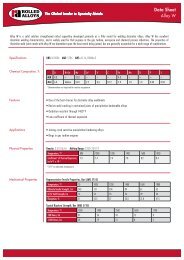
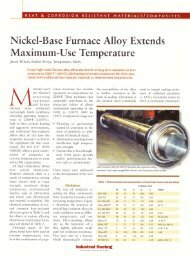
![RA333 Data Sheet [Heat Resistant Alloys] - Rolled Alloys](https://img.yumpu.com/50335849/1/190x245/ra333-data-sheet-heat-resistant-alloys-rolled-alloys.jpg?quality=85)
